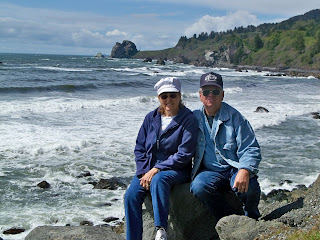 RHYOLITE
RHYOLITE GHOST TOWN, NV
Shorty Harris and Ed Cross found gold just outside of Death Valley, CA, in the early 1900s. Because of this discovery, the mining town of
Rhyolite was built. In her
heyday, R
hyolite had 3 water systems, 3 train lines, over 50 mines, 2 hospitals, 8 doctors, 2 dentists, 19 lodging house, 18 grocery stores, over 50 saloons, and a Catholic and a Presbyterian Church,
Rhyolite is the largest ghost town in Death Valley.

The
Rhyolite Mercantile. The life span of
Rhyolite was about 10 years with some residents holding our for another 4 or 5 years.
Population: 1905-1911 up to 8000 people.
1912-1919 declined to 20 families
Today - 1 other than BLM Caretakers

Bill found this "fixer upper" but decided it wouldn't haul the RV.
Tom Kelly's Bottle House is one of the few still remaining houses made entirely out of bottles. Seems there were plenty of available bottles from the 50 saloons in town!

Thousands of photographers come to R
hyolite every year for the opportunity of a lifetime. This is the remains of the three-story
Cook Bank Building, the most photographed ruin in the state of Nevada.

One of the few remaining buildings still in decent shape is the old train depot which later became a casino. It, too, is now deserted.

Just down the road is the
Goldwell Open Air Museum which began in 1984 as an artist project of Belgian sculptor
Albert Szukalski, best known for his life-size "ghostly" shrouded figures. To make the figures,
Szukalski wrapped live models in fabric soaked in wet plaster, posed them, and refined the drapery. When the plaster set, the model was slipped out, leaving the rigid shroud that surrounded them. This is called "
THE LAST SUPPER".
 Szukalski's
Szukalski's figures are found throughout the city in Antwerp, Belgium. This one is called "
Ghost Rider". The model, a local man, donated his bicycle to complete the piece.

This eclectic couch was
originally created for an artist-in-residence project at the Lied Discovery Children's
s Museum in
Las Vegas. It was rescued in 2007 and lovingly restored and re-envisioned at G
oldwell in 2007.

Sunset from our campsite at the Longstreet RV Park in the Nevada desert was a beautiful vision. Each evening Bill and I would sit and watch the sunset.

























































